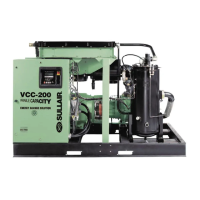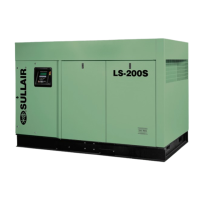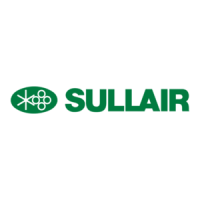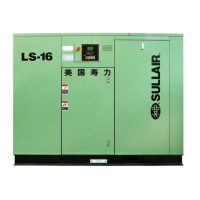Section 2
DESCRIPTION
8
pressor unit.
Fluid flows from the bottom of the receiver/sump to
the thermal valve. The thermal valve is fully open
when the fluid temperature is below 175ºF (79ºC).
The fluid passes through the thermal valve, the
main filter and directly to the compressor unit where
it lubricates, cools and seals the rotors and the
compression chamber.
As the discharge temperature rises above 175ºF
(79ºC), due to the heat of compression, the thermal
valve begins to close and a portion of the fluid then
flows through the cooler. From the cooler the fluid
flows to the main filter and then on to the compres-
sor unit.
A portion of the fluid flowing to the compressor is
routed to the anti-friction bearings which support
the rotors inside the compressor unit. Prior to enter-
ing the compressor unit, this fluid is taken through
the fluid filter, thus assuring properly filtered lubri-
cant for bearing supply.
The fluid filter has a replacement element and an
integral pressure bypass valve. An indicator on the
instrument panel shows when the filter needs serv-
icing. This indicator has a pressure setting lower
than that of the bypass valve. The indicator should
be checked with compressor running at full system
pressure.
Water-cooled models have a water pressure switch
to prevent operation with inadequate water pres-
sure.
2.5 COMPRESSOR DISCHARGE SYSTEM, FUNC-
TIONAL DESCRIPTION
Refer to Figures 2-2A and 2-2B. The compressor
unit discharges the compressed air/fluid mixture
into the combination receiver/sump.
The receiver has three basic functions:
1. It acts as a primary fluid separator.
2. Serves as the compressor fluid sump.
3. Houses the final fluid separator.
The compressed air/fluid mixture enters the receiv-
er and is directed against the internal baffle. The
direction of movement is changed and its velocity
significantly reduced, thus causing large droplets of
fluid to form and fall to the bottom of the
receiver/sump. The fractional percentage of fluid
remaining in the compressed air collects on the sur-
face of the separator element as the compressed
air flows through the separator. A return line (or
scavenge tube) leads from the bottom of the sepa-
rator element to the inlet region of the compressor
unit. Fluid collecting on the bottom of the separator
is returned to the compressor by a pressure differ-
ential between the receiver and the compressor
inlet. A visual sight glass is located on the return
line to observe this fluid flow. There is also an ori-
fice in this return line (protected by a strainer) to
assure proper flow. A secondary separator element
with a separate return line, strainer, sight glass and
orifice further reduce the fluid carry-over to less
than 2 ppm (parts per million). An indicator, located
on the instrument panel, shows if abnormal pres-
sure drop through the separator develops. At this
time, separator element replacement is necessary.
This indicator must be checked with the compres-
sor running fully loaded.
A minimum pressure/check valve, located down-
stream from the separator, assures a minimum
receiver pressure of 50 psig (3.5 bar) during loaded
conditions. This pressure is necessary for proper
air/fluid separation and proper fluid circulation.
A terminal check valve is incorporated into the min-
imum pressure/check valve to prevent compressed
air in the service line from bleeding back into the
receiver on shutdown and during operation of the
compressor in an unloaded condition.
A pressure relief valve (located on the wet side of
the separator) is set to open if the sump pressure
exceeds the sump tank rating. A temperature switch
will shut down the compressor if the discharge tem-
perature reaches 235ºF (113ºC).
Fluid is added to the sump via a capped fluid filler
opening, placed low on the tank to prevent overfill-
ing of the sump. A sight glass enables the operator
to visually monitor the sump fluid level.
2.6 CONTROL SYSTEM, FUNCTIONAL DESCRIP-
TION- SUPERVISOR CONTROLLER™
Refer to Figures 2-3A (without spiral valve) or 2-3B
(with spiral valve). The purpose of the compressor
Control System is to regulate the amount of air
being compressed to match the amount of com-
pressed air being used. The Capacity Control
System consists of a solenoid valve, regulator
valve and an inlet valve. The functional description
of the Control System is described below in four
distinct phases of operation. The following descrip-
tion text applies to all 200 Series compressors with
optional Supervisor Controller. For explanatory pur-
DO NOT remove caps, plugs, and/or other com-
ponents when compressor is running or pressur-
ized.
Stop compressor and relieve all internal pressure
before doing so.

